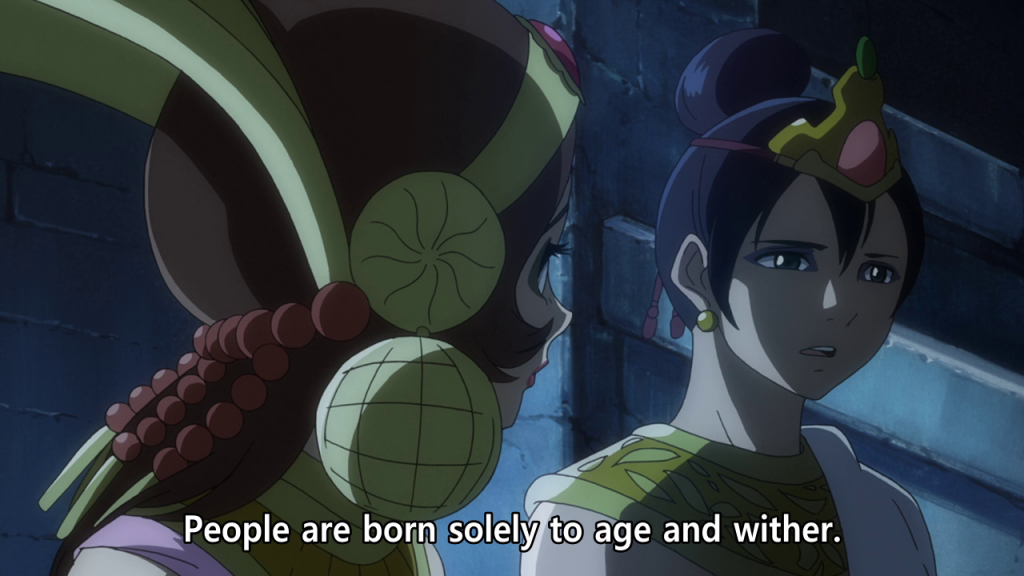
I never bought the argument that sacred stories, figures, and themes should not be brought to pop culture media like films or novels. Some of our more powerful and compelling pieces of modern fiction (and indeed, fiction from any era) was informed by not just the author’s spiritual identity or values, but by their intentional deployment of religious figures and ideas to shape the narrative and deliver the message of the novel, comic, film, or cartoon.
A long time ago I got into a discussion with someone about the accuracy of Osamu Tezuka’s Buddha manga serial. The animated adaptation hadn’t yet been released—the two films have not been critically successful, although I would argue it is largely due to the film’s internal structure and poor use of Tezuka’s source material rather than any overarching problem with depictions of the Buddha. The manga itself was far more self-referential, bawdy, and subversive than this particular person was prepared for. His main complaint, however, was that it depicted the life of the Buddha inaccurately and therefore risked misleading people who were sincerely searching for the Dharma.
I want nothing more than for more people to draw closer to accurate Buddhist teachings. However, I have real difficulty with this argument.
This claim does have some merit, of course. Creations of fiction are almost by definition not rooted in the “real” world, even stories that purport to be set in our reality. I certainly wouldn’t go so far as to suggest Buddhist temples stock their libraries with media made to entertain rather than enlighten. Yet I cannot help but feel that any critical consumer of such “inaccurate” media will know, from the moment they access such media, that it is meant to approach humanity’s search for meaning in a different way.
I see creative license as our dialogue with our own heritage, our contemporary grappling with its meaning as well as the “gaps” between our inheritance’s messages. Filling the spaces, which are constantly open and re-opening, requires human imagination and hermeneutics to fill and express. Will such interpretations deviate from the traditional transmission of Buddhist lore? Inevitably. Will they be distasteful or unorthodox? It depends on the author. But will some also help us to see a different side of things and stimulate genuine interest in and sympathy for figures otherwise relegated to Dharma talks and books? I think this is not only achievable but also ideal. More media means more exposure. More (good quality) exposure means more interest in the forces behind the author’s inspiration. This is soft power at its most basic.
The sympathetic Satan of John Milton’s Paradise Lost would be unrecognizable to the Christians of medieval Europe. Yet Milton’s Satan has been incredibly important in Western literature, without which our fascination with one of Christianity’s central figures would be immensely diminished. One of the most influential and gripping graphic novel series in the past couple of decades was titled Lucifer, specifically about the rebellious angel who is sick of playing God’s unwinnable game in governing Hell and leaves to open a jazz bar in Los Angeles. Yet I know of very few decrying Neil Gaiman and Mike Carey’s creation (now with its own TV series on Fox) as being inaccurate to the Bible or to the true character of Satan, who surely remains the premier antagonistic force in orthodox Christian theology.
There will be duds and misses as more people draw inspiration from Buddhist stories. And figures within Buddhist lore will not be depicted as they are in the canonical scriptures. Yet such media, if done well, implants Buddhism in the public consciousness as not simply a philosophy to be accepted, debated, or rejected (in other words, a compartmentalized entity), but as a fundamental presence. It’s just there, waiting to be accessed. And every generation breathes new life into the forum of Buddhist narratives, yearnings, and priorities, by tweaking old stories or telling entirely new ones. Personally, I don’t see that as a bad thing.
Related features from Buddhistdoor Global
Dharma Screenings: Buddhist Film and Pop Culture—Buddha 2: A Flawed Production with Compelling Characters
Dharma Screenings: Buddhist Film and Pop Culture—Buddhist Traditions on the Silver Screen
Dharma Screenings: Buddhist Film and Pop Culture—Bringing Buddhism to Creative Media


[…] Related blogs from Buddhistdoor GlobalPop Culture: The Case for a Greater Buddhist Presence […]